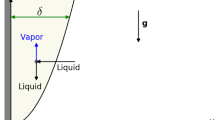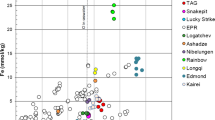Abstract
This paper describes a fluid dynamical investigation of the influx of hot, dense ultrabasic magma into a reservoir containing lighter, fractionated basaltic magma. This situation is compared with that which develops when hot salty water is introduced under cold fresh water. Theoretical and empirical models for salt/water systems are adapted to develop a model for magmatic systems. A feature of the model is that the ultrabasic melt does not immediately mix with the basalt, but spreads out over the floor of the chamber, forming an independent layer. A non-turbulent interface forms between this layer and the overlying magma layer across which heat and mass are transferred by the process of molecular diffusion. Both layers convect vigorously as heat is transferred to the upper layer at a rate which greatly exceeds the heat lost to the surrounding country rock. The convection continues until the two layers have almost the same temperature. The compositions of the layers remain distinct due to the low diffusivity of mass compared to heat. The temperatures of the layers as functions of time and their cooling rate depend on their viscosities, their thermal properties, the density difference between the layers and their thicknesses. For a layer of ultrabasic melt (18% MgO) a few tens of metres thick at the base of a basaltic (10% MgO) magma chamber a few kilometres thick, the temperature of the layers will become nearly identical over a period of between a few months and a few years. During this time the turbulent convective velocities in the ultrabasic layer are far larger than the settling velocity of olivines which crystallise within the layer during cooling. Olivines only settle after the two layers have nearly reached thermal equilibrium. At this stage residual basaltic melt segregates as the olivines sediment in the lower layer. Depending on its density, the released basalt can either mix convectively with the overlying basalt layer, or can continue as a separate layer. The model provides an explanation for large-scale cyclic layering in basic and ultrabasic intrusions. The model also suggests reasons for the restriction of erupted basaltic liquids to compositions with MgO<10% and the formation of some quench textures in layered igneous rocks.
Similar content being viewed by others
References
Andersen AT (1976) Magma mixing: petrological process and volcanological tool. J Vol Geoth Pres 1:3–33
Barnea E, Mizrahi J (1973) A generalized approach to the fluid dynamics of particulate systems. Part I. General correlation for fluidization and sedimentation in solid multiparticle systems. Chem Eng 5:171–189
Batchelor GK (1965) The motion of small particles in turbulent flow. The Second Australian Conference on Hydraulics and Fluid Mechanics 019–041
Berg JH Snowflake troctolite in the Hettasch Intrusion, Labrador: evidence for magma-mixing and supercooling in a plutonic environment. Contrib Mineral Petrol (in press)
Bjornsson A, Johnsen G, Sigurdsson S, Thorbergsson G, Truggvason E (1979) Rifting of the plate boundary in North Iceland, 1975–1978. J Geophys Res 84:3029–3038
Bottinga Y, Richet P (1978) Thermodynamics of liquid silicates. A preliminary report. Earth Planet Sci Lett 40:382–400
Bottinga Y, Weill DF (1970) Densities of liquid silicate systems calculated from partial molar volumes of oxide components. Am J Sci 269:169–182
Brown GM (1956) The layered ultrabasic rocks of Rhum Inner Hebrides. Philos Trans R Soc London B240:1–53
Busse FH (1978) Non-linear properties of thermal convection. Rep Prog Phys 41:1929–1967
Carslaw HS, Jaeger JC (1959) Conduction of Heat in Solids. Oxford University Press
Clarke DB, O'Hara MJ (1979) Nickel and the existence of high magnesia liquids. Earth Planet Sci Lett 44:153–158
Cox KG (1978) Komatiites and other high-magnesia lavas: some problems. Philos Trans R Soc London A288:599–509
Deardorff JW, Willis GE (1967) Investigation of turbulent thermal convection between horizontal plates. J Fluid Mech 28:675–704
Donaldson CH (1976) An experimental investigation of olivine morphology. Contrib Mineral Petrol 57:187–213
Donaldson CH (1977) Laboratory duplication of comb-layering in the Rhum pluton. Mineral Mag 41:323–336
Donaldson CH, Brown RW (1977) Refractory megacrysts and magnesium-rich melt inclusions with spinel in oceanic tholeiites: indicators of magma mixing and parental magma composition. Earth Planet Sci Lett 37:81–89
Dunham AC, Wadsworth WJ (1978) Cryptic variation in the Rhum layered intrusion. Mineral Mag 42:347–356
Eichelberger JC (1978) Andesitic volcanism and crustal evolution. Nature 275:21–27
Elthon D (1979) High magnesia liquids as the parental magma for ocean floor basalts. Nature 278:514–518
Gibb FGF (1976) Ultrabasic rocks of Rhum and Skye: the nature of the parent magma. J Geol Soc, London 132:209–222
Green DH, Hibberson WO, Jacques AL (1979) Petrogenesis of mid-ocean ridge basalts. In: E McElhinny (ed), The Earth: its origin, structure and evolution, pp 265–289
Hildreth WS (1979) The Bishop Tuff: Evidence for the origin of compositional zonation in silicic magma chambers. Geo Soc Am, Spec Pap 180:43–76
Huppert HE (1971) On the stability of a series of double-diffusive layers. Deep-Sea Res 18:1005–1021
Huppert HE, Sparks RSJ (1980) Restrictions on the compositions of mid-ocean ridge basalts: a fluid dynamical investigation. Nature 286:46–48
Huppert HE, Turner JS (1972) Double-diffusive convection and its implications for the temperature and salinity structure of the ocean and Lake Vanda. J Phys Oceanogr 2:456–461
Irvine TN (1977) Origin of chromitite layers in the Muskox intrusion and other stratiform intrusions: a new interpretation. Geology 5:273–277
Irvine TN (1979) Rocks whose composition is determined by crystal accumulation and sorting. In: HS Yoder Jr (ed), The Evolution of Igneous Rocks, pp 245–306
Irvine TN, Smith CH (1967) The ultramafic rocks of the Muskox Intrusion. In: PJ Wyllie (ed). Ultramafic and Related Rocks. John Wiley & Sons, New York, pp 38–49
Krishnamurthy P, Cox KG (1977) Picrite basalts and related lavas from the Deccan Traps of Western India. Contrib Mineral Petrol 62:53–75
Krishnamurthi R (1970) On the transition to turbulent convection. Part 2. The transition to time-dependent flow. J Fluid Mech 42:309–320
Maaloe S (1978) The origin of rhythmic layering. Mineral Mag 42:337–345
McBirney AR, Noyes RM (1979) Crystallization and layering of the Skaergaard Intrusion. J Petrol 20:487–554
Nelson SA, Carmichael ISA (1979) Partial molar volumes of oxide components in silicate liquids. Contrib Mineral Petrol 71:117–124
Nisbet EG, Fowler CMR (1978) The mid-Atlantic ridge at 37 and 45° N: some geophysical and petrological constraints. Geophys JR Astron Soc Canada 54:631–660
O'Hara MJ (1968) The bearing of phase equilibria studies in synthetic and natural systems on the origin of evolution of basic and ultrabasic rocks. Earth Sci Rev 4:69–133
O'Hara MJ (1977) Geochemical evolution during fractional crustallization of a periodically refilled magma chamber. Nature 266:503–507
Rhodes JM, Dungan MA, Blanchard DP, Long PE (1977) Magma mixing at mid-ocean ridges: evidence from basalts drilled near 22° N on the mid-Atlantic ridge. Tectonophysics 55:35–62
Rosendahl BR (1976) Evolution of ocean crust, 2. Constraints, implications and inferrences. J Geophys Res 81:5305–5314
Shaw HR (1972) Viscosities of magmatic silicate liquids: an empirical method of prediction. Am J Sci 272:870–893
Sigurdsson H, Sparks RSJ (1978) Lateral magma flow within rifted Icelandic crust. Nature 274:126–130
Smith RL (1979) Ash-flow magmatism. Geol Soc Am, Spec Pap 180:5–28
Smewing JD Mixing characteristics and compositional differences in mantle-derived melts beneath spreading axes; evidence from cyclically layered rocks in the ophiolite of North Oman. J Geophys Res (in press)
Sparks RSJ, Meyer P, Sigurdsson H (1980) Density variations amoungst mid-ocean ridge basalts: Implications for magma mixing and the scareity of primitive lavas. Earth Planet Sci Lett 46:419–430
Sparks RSJ, Sigurdsson H, Wilson L (1977) Magma mixing: a mechanism of triggering acid explosive eruptions. Nature 267:315–318
Stolper E, Walker D (1980) Melt density and the average composition of basalt. Contrib Mineral Petrol 74:7–12
Thompson RN (1973) One atmosphere melting behaviour and nomenclature of terrestial lavas. Contrib Mineral Petrol 40:197–204
Townsend AA (1976) The Structure of Turbulent Shear Flow. Cambridge University Press
Turner JS (1979) Buoyancy Effects in Fluids. Cambridge University Press
Usselman TM, Hodge DS (1978) Thermal control of low-pressure fractionation processes. J Volcan Geo Res 4:265–281
Wadsworth WJ (1961) The layered ultrabasic rocks of south-west Rhum, Inner Hebrides. Philos Trans R Soc London B244:21–64
Wager LR, Brown GM (1968) Layered Igneous Rocks. Oliver Boyd, Edinburgh
Wager, LR, Deer WA (1939) Geological investigations in East Greenland, Part III. The petrology of the Skaergaard Intrusion, Kangerdugssuaq, East Greenland. Medd Groenl 105 (No. 4):1–352
Walker D, Shibata T, Long SE (1979) Abyssal tholeiites from the Oceanographer Fracture Zone, II. Phase equilibria and mixing. Contrib Mineral Petrol 70:111–125
Author information
Authors and Affiliations
Rights and permissions
About this article
Cite this article
Huppert, H.E., Sparks, R.S.J. The fluid dynamics of a basaltic magma chamber replenished by influx of hot, dense ultrabasic magma. Contr. Mineral. and Petrol. 75, 279–289 (1981). https://doi.org/10.1007/BF01166768
Received:
Accepted:
Issue Date:
DOI: https://doi.org/10.1007/BF01166768




